Lin Li
and Other Contributors
UniVoice: Unifying Autoregressive ASR and Flow-Matching based TTS with Large Language Models
Oct 06, 2025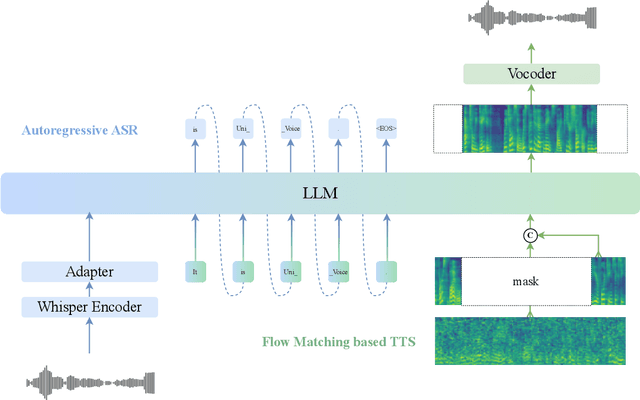
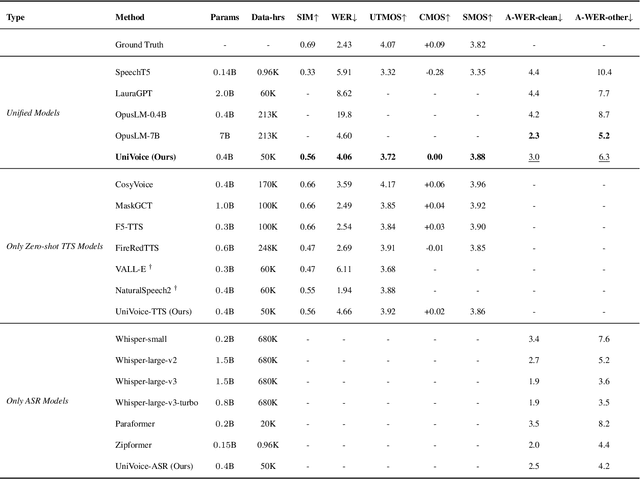
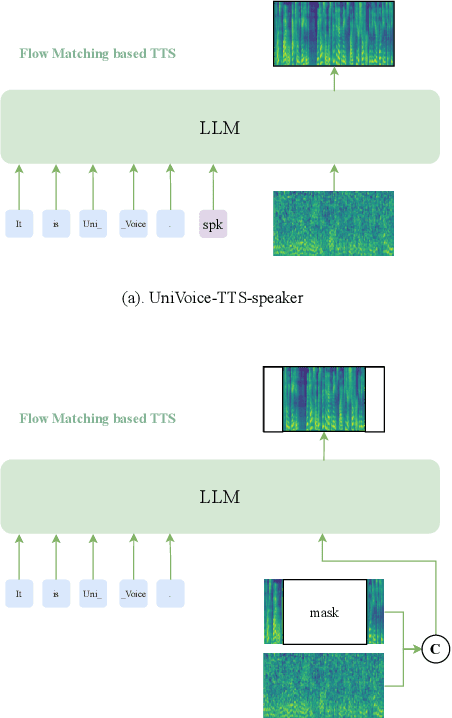

Abstract:Large language models (LLMs) have demonstrated promising performance in both automatic speech recognition (ASR) and text-to-speech (TTS) systems, gradually becoming the mainstream approach. However, most current approaches address these tasks separately rather than through a unified framework. This work aims to integrate these two tasks into one unified model. Although discrete speech tokenization enables joint modeling, its inherent information loss limits performance in both recognition and generation. In this work, we present UniVoice, a unified LLM framework through continuous representations that seamlessly integrates speech recognition and synthesis within a single model. Our approach combines the strengths of autoregressive modeling for speech recognition with flow matching for high-quality generation. To mitigate the inherent divergence between autoregressive and flow-matching models, we further design a dual attention mechanism, which switches between a causal mask for recognition and a bidirectional attention mask for synthesis. Furthermore, the proposed text-prefix-conditioned speech infilling method enables high-fidelity zero-shot voice cloning. Experimental results demonstrate that our method can achieve or exceed current single-task modeling methods in both ASR and zero-shot TTS tasks. This work explores new possibilities for end-to-end speech understanding and generation.
Goal-Guided Efficient Exploration via Large Language Model in Reinforcement Learning
Sep 26, 2025Abstract:Real-world decision-making tasks typically occur in complex and open environments, posing significant challenges to reinforcement learning (RL) agents' exploration efficiency and long-horizon planning capabilities. A promising approach is LLM-enhanced RL, which leverages the rich prior knowledge and strong planning capabilities of LLMs to guide RL agents in efficient exploration. However, existing methods mostly rely on frequent and costly LLM invocations and suffer from limited performance due to the semantic mismatch. In this paper, we introduce a Structured Goal-guided Reinforcement Learning (SGRL) method that integrates a structured goal planner and a goal-conditioned action pruner to guide RL agents toward efficient exploration. Specifically, the structured goal planner utilizes LLMs to generate a reusable, structured function for goal generation, in which goals are prioritized. Furthermore, by utilizing LLMs to determine goals' priority weights, it dynamically generates forward-looking goals to guide the agent's policy toward more promising decision-making trajectories. The goal-conditioned action pruner employs an action masking mechanism that filters out actions misaligned with the current goal, thereby constraining the RL agent to select goal-consistent policies. We evaluate the proposed method on Crafter and Craftax-Classic, and experimental results demonstrate that SGRL achieves superior performance compared to existing state-of-the-art methods.
MeanFlowSE: one-step generative speech enhancement via conditional mean flow
Sep 18, 2025Abstract:Multistep inference is a bottleneck for real-time generative speech enhancement because flow- and diffusion-based systems learn an instantaneous velocity field and therefore rely on iterative ordinary differential equation (ODE) solvers. We introduce MeanFlowSE, a conditional generative model that learns the average velocity over finite intervals along a trajectory. Using a Jacobian-vector product (JVP) to instantiate the MeanFlow identity, we derive a local training objective that directly supervises finite-interval displacement while remaining consistent with the instantaneous-field constraint on the diagonal. At inference, MeanFlowSE performs single-step generation via a backward-in-time displacement, removing the need for multistep solvers; an optional few-step variant offers additional refinement. On VoiceBank-DEMAND, the single-step model achieves strong intelligibility, fidelity, and perceptual quality with substantially lower computational cost than multistep baselines. The method requires no knowledge distillation or external teachers, providing an efficient, high-fidelity framework for real-time generative speech enhancement.
Transplant-Ready? Evaluating AI Lung Segmentation Models in Candidates with Severe Lung Disease
Sep 18, 2025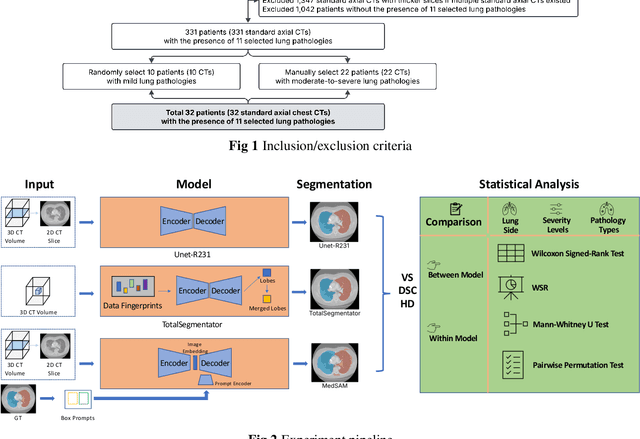
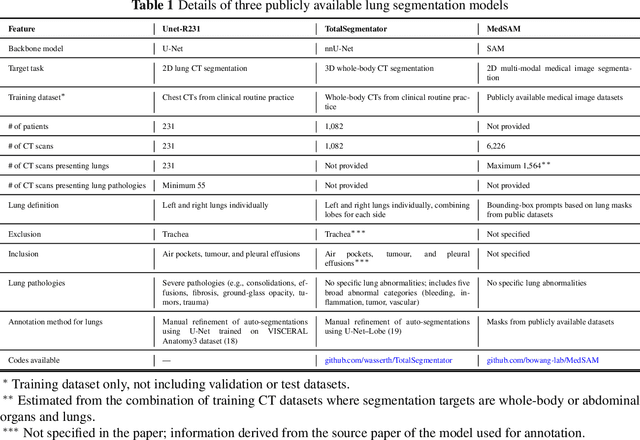
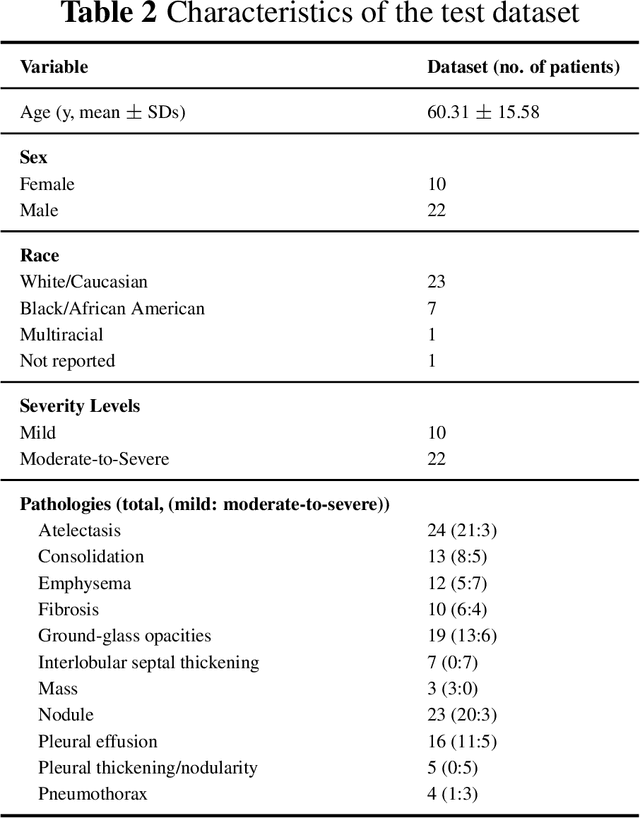
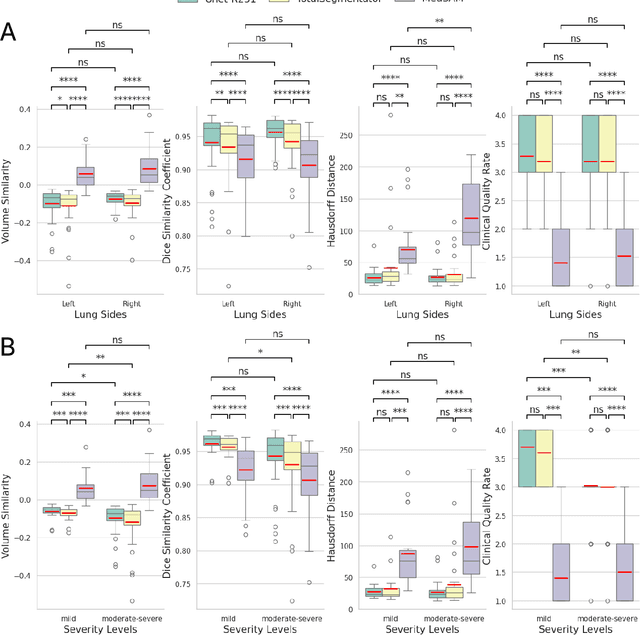
Abstract:This study evaluates publicly available deep-learning based lung segmentation models in transplant-eligible patients to determine their performance across disease severity levels, pathology categories, and lung sides, and to identify limitations impacting their use in preoperative planning in lung transplantation. This retrospective study included 32 patients who underwent chest CT scans at Duke University Health System between 2017 and 2019 (total of 3,645 2D axial slices). Patients with standard axial CT scans were selected based on the presence of two or more lung pathologies of varying severity. Lung segmentation was performed using three previously developed deep learning models: Unet-R231, TotalSegmentator, MedSAM. Performance was assessed using quantitative metrics (volumetric similarity, Dice similarity coefficient, Hausdorff distance) and a qualitative measure (four-point clinical acceptability scale). Unet-R231 consistently outperformed TotalSegmentator and MedSAM in general, for different severity levels, and pathology categories (p<0.05). All models showed significant performance declines from mild to moderate-to-severe cases, particularly in volumetric similarity (p<0.05), without significant differences among lung sides or pathology types. Unet-R231 provided the most accurate automated lung segmentation among evaluated models with TotalSegmentator being a close second, though their performance declined significantly in moderate-to-severe cases, emphasizing the need for specialized model fine-tuning in severe pathology contexts.
VoxHammer: Training-Free Precise and Coherent 3D Editing in Native 3D Space
Aug 26, 2025



Abstract:3D local editing of specified regions is crucial for game industry and robot interaction. Recent methods typically edit rendered multi-view images and then reconstruct 3D models, but they face challenges in precisely preserving unedited regions and overall coherence. Inspired by structured 3D generative models, we propose VoxHammer, a novel training-free approach that performs precise and coherent editing in 3D latent space. Given a 3D model, VoxHammer first predicts its inversion trajectory and obtains its inverted latents and key-value tokens at each timestep. Subsequently, in the denoising and editing phase, we replace the denoising features of preserved regions with the corresponding inverted latents and cached key-value tokens. By retaining these contextual features, this approach ensures consistent reconstruction of preserved areas and coherent integration of edited parts. To evaluate the consistency of preserved regions, we constructed Edit3D-Bench, a human-annotated dataset comprising hundreds of samples, each with carefully labeled 3D editing regions. Experiments demonstrate that VoxHammer significantly outperforms existing methods in terms of both 3D consistency of preserved regions and overall quality. Our method holds promise for synthesizing high-quality edited paired data, thereby laying the data foundation for in-context 3D generation. See our project page at https://huanngzh.github.io/VoxHammer-Page/.
Synchrosqueezed X-Ray Wavelet-Chirplet Transform for Accurate Chirp Rate Estimation and Retrieval of Modes from Multicomponent Signals with Crossover Instantaneous Frequencies
Aug 25, 2025Abstract:Recent advances in the chirplet transform and wavelet-chirplet transform (WCT) have enabled the estimation of instantaneous frequencies (IFs) and chirprates, as well as mode retrieval from multicomponent signals with crossover IF curves. However, chirprate estimation via these approaches remains less accurate than IF estimation, primarily due to the slow decay of the chirplet transform or WCT along the chirprate direction. To address this, the synchrosqueezed chirplet transform (SCT) and multiple SCT methods were proposed, achieving moderate improvements in IF and chirprate estimation accuracy. Nevertheless, a novel approach is still needed to enhance the transform's decay along the chirprate direction. This paper introduces an X-ray transform-based wavelet-chirprate transform, termed the X-ray wavelet-chirplet transform (XWCT), which exhibits superior decay along the chirprate direction compared to the WCT. Furthermore, third-order synchrosqueezed variants of the WCT and XWCT are developed to yield sharp time-frequency-chirprate representations of signals. Experimental results demonstrate that the XWCT achieves significantly faster decay along the chirprate axis, while the third-order synchrosqueezed XWCT enables accurate IF and chirprate estimation, as well as mode retrieval, without requiring multiple synchrosqueezing operations.
Enhancing Transferability and Consistency in Cross-Domain Recommendations via Supervised Disentanglement
Jul 23, 2025Abstract:Cross-domain recommendation (CDR) aims to alleviate the data sparsity by transferring knowledge across domains. Disentangled representation learning provides an effective solution to model complex user preferences by separating intra-domain features (domain-shared and domain-specific features), thereby enhancing robustness and interpretability. However, disentanglement-based CDR methods employing generative modeling or GNNs with contrastive objectives face two key challenges: (i) pre-separation strategies decouple features before extracting collaborative signals, disrupting intra-domain interactions and introducing noise; (ii) unsupervised disentanglement objectives lack explicit task-specific guidance, resulting in limited consistency and suboptimal alignment. To address these challenges, we propose DGCDR, a GNN-enhanced encoder-decoder framework. To handle challenge (i), DGCDR first applies GNN to extract high-order collaborative signals, providing enriched representations as a robust foundation for disentanglement. The encoder then dynamically disentangles features into domain-shared and -specific spaces, preserving collaborative information during the separation process. To handle challenge (ii), the decoder introduces an anchor-based supervision that leverages hierarchical feature relationships to enhance intra-domain consistency and cross-domain alignment. Extensive experiments on real-world datasets demonstrate that DGCDR achieves state-of-the-art performance, with improvements of up to 11.59% across key metrics. Qualitative analyses further validate its superior disentanglement quality and transferability. Our source code and datasets are available on GitHub for further comparison.
Cooperative Circumnavigation for Multi-Quadrotor Systems via Onboard Sensing
Jun 26, 2025Abstract:A cooperative circumnavigation framework is proposed for multi-quadrotor systems to enclose and track a moving target without reliance on external localization systems. The distinct relationships between quadrotor-quadrotor and quadrotor-target interactions are evaluated using a heterogeneous perception strategy and corresponding state estimation algorithms. A modified Kalman filter is developed to fuse visual-inertial odometry with range measurements to enhance the accuracy of inter-quadrotor relative localization. An event-triggered distributed Kalman filter is designed to achieve robust target state estimation under visual occlusion by incorporating neighbor measurements and estimated inter-quadrotor relative positions. Using the estimation results, a cooperative circumnavigation controller is constructed, leveraging an oscillator-based autonomous formation flight strategy. We conduct extensive indoor and outdoor experiments to validate the efficiency of the proposed circumnavigation framework in occluded environments. Furthermore, a quadrotor failure experiment highlights the inherent fault tolerance property of the proposed framework, underscoring its potential for deployment in search-and-rescue operations.
MiniMax-M1: Scaling Test-Time Compute Efficiently with Lightning Attention
Jun 16, 2025Abstract:We introduce MiniMax-M1, the world's first open-weight, large-scale hybrid-attention reasoning model. MiniMax-M1 is powered by a hybrid Mixture-of-Experts (MoE) architecture combined with a lightning attention mechanism. The model is developed based on our previous MiniMax-Text-01 model, which contains a total of 456 billion parameters with 45.9 billion parameters activated per token. The M1 model natively supports a context length of 1 million tokens, 8x the context size of DeepSeek R1. Furthermore, the lightning attention mechanism in MiniMax-M1 enables efficient scaling of test-time compute. These properties make M1 particularly suitable for complex tasks that require processing long inputs and thinking extensively. MiniMax-M1 is trained using large-scale reinforcement learning (RL) on diverse problems including sandbox-based, real-world software engineering environments. In addition to M1's inherent efficiency advantage for RL training, we propose CISPO, a novel RL algorithm to further enhance RL efficiency. CISPO clips importance sampling weights rather than token updates, outperforming other competitive RL variants. Combining hybrid-attention and CISPO enables MiniMax-M1's full RL training on 512 H800 GPUs to complete in only three weeks, with a rental cost of just $534,700. We release two versions of MiniMax-M1 models with 40K and 80K thinking budgets respectively, where the 40K model represents an intermediate phase of the 80K training. Experiments on standard benchmarks show that our models are comparable or superior to strong open-weight models such as the original DeepSeek-R1 and Qwen3-235B, with particular strengths in complex software engineering, tool utilization, and long-context tasks. We publicly release MiniMax-M1 at https://github.com/MiniMax-AI/MiniMax-M1.
SuPseudo: A Pseudo-supervised Learning Method for Neural Speech Enhancement in Far-field Speech Recognition
May 30, 2025Abstract:Due to the lack of target speech annotations in real-recorded far-field conversational datasets, speech enhancement (SE) models are typically trained on simulated data. However, the trained models often perform poorly in real-world conditions, hindering their application in far-field speech recognition. To address the issue, we (a) propose direct sound estimation (DSE) to estimate the oracle direct sound of real-recorded data for SE; and (b) present a novel pseudo-supervised learning method, SuPseudo, which leverages DSE-estimates as pseudo-labels and enables SE models to directly learn from and adapt to real-recorded data, thereby improving their generalization capability. Furthermore, an SE model called FARNET is designed to fully utilize SuPseudo. Experiments on the MISP2023 corpus demonstrate the effectiveness of SuPseudo, and our system significantly outperforms the previous state-of-the-art. A demo of our method can be found at https://EeLLJ.github.io/SuPseudo/.
 Add to Chrome
Add to Chrome Add to Firefox
Add to Firefox Add to Edge
Add to Edge